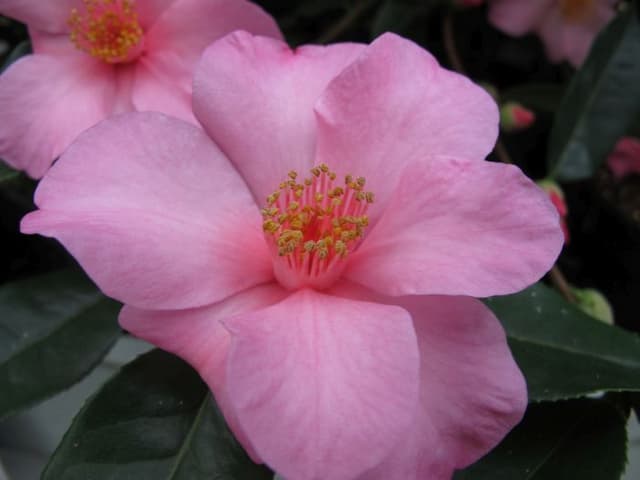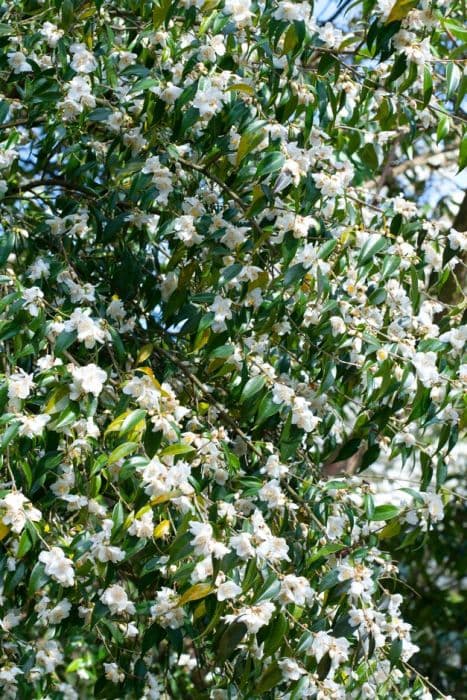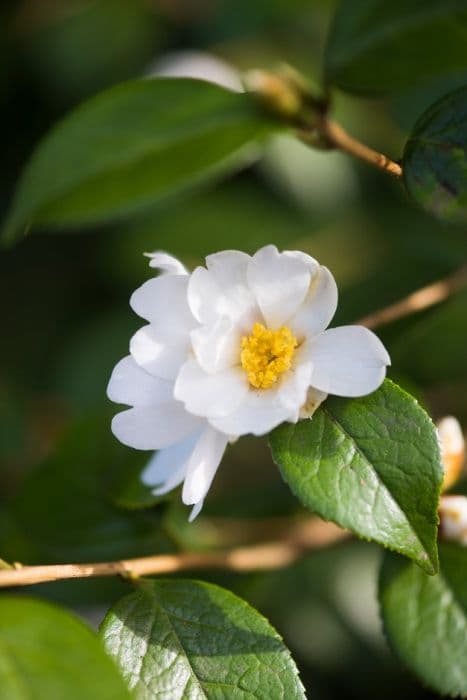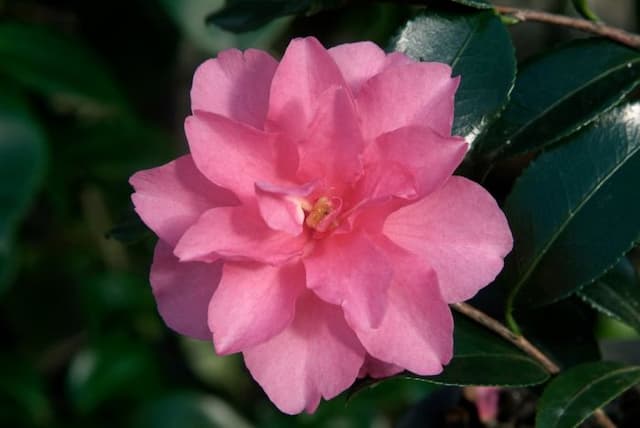Williamsii Camellia Camellia × williamsii 'Tiptoe'

ABOUT
The 'Tiptoe' variety of the plant often referred to as a camellia boasts delicate, elegant flowers that are sure to catch the eye. The blooms of this plant typically present in a soft shade of pink, which can range from a pale, almost blush tone to a richer, deeper hue. Each blossom is formed in a classic shape that is symmetrical and pleasing to the eye, with petals that are sometimes gently ruffled along their edges, adding to the overall softness of the flower's appearance. As a perennial, the 'Tiptoe' features glossy green leaves that offer a year-round display of lush foliage. The leaves are usually oval-shaped with a slightly pointed tip and are leathery to the touch, providing a beautiful backdrop to the flowers. This evergreen nature ensures that even when not in bloom, the plant retains its vibrant green appearance. The flowers are of a substantial size and contrast beautifully against the dark green leaves, creating a stunning visual display. During the blooming season, this plant becomes a focal point in the garden, with its blossoms attracting both visual attention and pollinators such as bees and butterflies. Despite the omission of specific size measurements, it's worth noting that the overall growth habit of 'Tiptoe' is well-proportioned and suitable for incorporation into a range of garden styles, from formal to cottage gardens. This variety is cultivated for its aesthetic appeal and performance in the landscape, ensuring that it remains a popular choice among garden enthusiasts.
About this plant
 Names
NamesFamily
Theaceae
Synonyms
Williamsii Camellia, Tiptoe Camellia
Common names
Camellia × williamsii 'Tiptoe'.
 Toxicity
ToxicityTo humans
The plant commonly known as Williamsii Camellia is generally considered non-toxic to humans. This means that ingestion of parts of Williamsii Camellia, such as leaves or flowers, does not typically result in poisoning or serious side effects. Therefore, there are no commonly recognized symptoms of poisoning or significant consequences directly associated with ingestion from this plant for humans.
To pets
Williamsii Camellia is not known to be toxic to pets. Like humans, pets that consume parts of this plant, such as leaves or flowers, are not expected to show symptoms of poisoning. Consequently, there are no well-documented toxic effects or life-threatening consequences for pets that ingest parts of the Williamsii Camellia. However, it is generally a good practice to prevent pets from eating plants as they can sometimes cause mild stomach upset or an allergic reaction.
 Characteristics
CharacteristicsLife cycle
Perennials
Foliage type
Evergreen
Color of leaves
Dark green
Flower color
Pink
Height
6-10 feet (1.8-3 meters)
Spread
6-10 feet (1.8-3 meters)
Plant type
Shrub
Hardiness zones
7-9
Native area
East Asia
Benefits
 General Benefits
General Benefits- Ornamental Appeal: The plant has attractive semi-double soft pink flowers that enhance the beauty of gardens and landscapes.
- Long Blooming Period: Camellia 'Tiptoe' typically has a long flowering season, providing color and interest for an extended period.
- Evergreen Foliage: The glossy, dark green leaves remain throughout the year, offering continuous foliage cover and structure.
- Shade Tolerance: It can grow in partially shaded areas, providing gardeners with a flowering option for less sunny spots.
- Winter Interest: As camellias often bloom in late winter to early spring, they add interest to gardens at a time when many other plants are dormant.
- Low Maintenance: Once established, 'Tiptoe' requires minimal care, making it suitable for gardeners looking for low-maintenance plants.
- Drought Resistance: The plant is relatively drought-tolerant once established, reducing the need for frequent watering.
- Versatility: It can be used in a variety of settings, including beds, borders, containers, or as a specimen plant.
- Wildlife Attraction: Camellias can attract pollinators such as bees to the garden.
- Cold Tolerance: 'Tiptoe' is reasonably hardy and can withstand cooler temperatures, which is beneficial for gardens in temperate zones.
 Medical Properties
Medical PropertiesThis plant is not used for medical purposes.
 Air-purifying Qualities
Air-purifying QualitiesThis plant is not specifically known for air purifying qualities.
 Other Uses
Other Uses- Culinary garnish: Flowers from the Camellia 'Tiptoe' can be used to add a decorative touch to dishes, particularly in fine dining experiences.
- Botanical art: The blossoms of the 'Tiptoe' can be used by artists as a subject for botanical illustration and other forms of plant-focused art.
- Eco-friendly confetti: Dried petals of the 'Tiptoe' can serve as a biodegradable confetti alternative for celebrations.
- Natural dye: The petals of this Camellia can be used to produce natural dyes for textiles and crafts, giving off subtle hues.
- Floral arrangements: Branches and flowers can be cut and used in formal floral arrangements, adding elegance to bouquets and centerpieces.
- Photography backdrop: The Camellia 'Tiptoe' can be used as a living backdrop for outdoor portrait photography due to its beautiful blooms.
- Educational resource: This plant can be included in educational programs about hybrid plant breeding and horticulture.
- Wedding decor: The attractive flowers and foliage can be incorporated into wedding decorations and bridal bouquets for a natural touch.
- Perfumery: Although not commonly used for their scent, the subtly fragrant blooms could potentially be used in the craft of perfume-making.
- Bee forage: Planting 'Tiptoe' can provide an early source of nectar for bees and other pollinators in the garden.
Interesting Facts
 Feng Shui
Feng ShuiThe Camellia is not used in Feng Shui practice.
 Zodiac Sign Compitability
Zodiac Sign CompitabilityThe Camellia is not used in astrology practice.
 Plant Symbolism
Plant Symbolism- Adoration: Camellias, in general, often symbolize adoration or deep desire. The Camellia × williamsii 'Tiptoe' could represent someone's deep, respectful affection for another.
- Perfection and Excellence: The flawless form and vibrant bloom of the Camellia × williamsii 'Tiptoe' can represent perfection or a quest for excellence.
- Enduring Love: The hardiness and long bloom time of camellias speak to enduring or long-lasting love that withstands trials and tribulations.
- Refinement: Camellias are associated with refinement and cultivated beauty, making them a symbol of high regard and unmatched grace.
- Longevity: Camellias, due to their evergreen nature and the longevity of their blooms, can symbolize life and immortality.
 Water
WaterWilliamsii Camellias like 'Tiptoe' should be watered to maintain evenly moist soil, particularly during the growing season, from spring through to fall. They require watering once or twice a week, depending on weather conditions. During drier periods, increase watering frequency without causing waterlogged conditions. Generally, applying 1 to 1.5 gallons of water per plant for each watering session is sufficient. In the winter, reduce watering but do not allow the soil to completely dry out.
 Light
LightWilliamsii Camellias such as 'Tiptoe' prefer dappled or partial shade. They thrive when protected from direct afternoon sun which can scorch their leaves. An ideal spot is under the light canopy of tall trees that filter sunlight or on the north or east side of buildings where they can receive bright but not direct morning light.
 Temperature
TemperatureWilliamsii Camellias like 'Tiptoe' do well in temperatures between 40 to 85 degrees Fahrenheit, but can survive brief dips just below freezing. They prefer a cool to moderate climate and should be protected from temperatures above 90 degrees Fahrenheit as extreme heat can damage them.
 Pruning
PruningPrune 'Tiptoe' Williamsii Camellias to remove dead or weak wood and to shape the plant after blooming in spring. Annual light pruning promotes vigorous growth and enhances flowering. Avoid heavy pruning which can reduce the number of flowers; the best time for pruning is just after the blooms have faded.
 Cleaning
CleaningAs needed
 Soil
SoilCamellia 'Tiptoe' thrives in acidic, well-draining soil with a pH between 5.5 and 6.5. A mix of 50% peat moss or coco coir, 30% perlite, and 20% organic compost creates an ideal environment for this camellia, providing it with the necessary acidity and drainage.
 Repotting
RepottingCamellia 'Tiptoe' should be repotted every two to three years or once it has outgrown its container, using the soil mixture as described earlier for best growth.
 Humidity & Misting
Humidity & MistingCamellia 'Tiptoe' prefers moderate to high humidity levels, ideally between 40-70%. Avoid placing in excessively dry environments to maintain its health.
 Suitable locations
Suitable locationsIndoor
Place Camellia 'Tiptoe' near bright, indirect light, monitor humidity.
Outdoor
Camellia 'Tiptoe' needs partial shade, sheltered position, moist soil.
Hardiness zone
Camellia 'Tiptoe' is suitable for 7-9 USDA.
 Life cycle
Life cycleCamellia × williamsii 'Tiptoe', commonly known as Camellia 'Tiptoe', starts its life cycle as a seed which, once germinated in moist, well-drained soil, develops into a seedling with the characteristic glossy, dark green leaves. As it matures into a young plant, it begins to form a woody structure and can be pruned to encourage bushy growth. It enters a vegetative stage where it continues to grow leaves and stems, becoming more robust and often taking a few years to begin flowering. The reproductive stage begins when the plant produces buds which eventually open into large, showy flowers typically from late winter to spring. After pollination, the flowers can develop into dry capsules containing seeds that can be dispersed to start new plants. The Camellia ‘Tiptoe’ is a perennial, thus this cycle is repeated annually, with the plant potentially living for several decades if given proper care.
 Propogation
PropogationPropogation time
Spring-Early Summer
The most popular method of propagating Camellia × williamsii 'Tiptoe', commonly known as Williamsii Camellia, is through semi-hardwood cuttings. This involves taking cuttings from the current year's growth in late summer, once the new shoots have started to harden slightly. Typically, a cutting of about 4 to 6 inches (10 to 15 cm) is snipped just below a leaf node. The lower leaves are removed, and the cut end may be dipped in rooting hormone to encourage root development. The cutting is then placed in a pot filled with a mixture of peat and perlite, ensuring at least one node is below the surface where roots will form. The pot is kept under high humidity and indirect light until roots have established, which usually takes several months. After rooting, the new plants can be gradually acclimatized to less humid conditions and eventually planted out.









